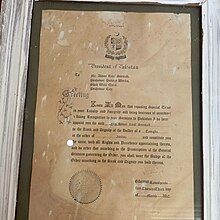Draft:Abul Rauf Seemab
| Submission declined on 23 October 2024 by Saqib (talk). This submission's references do not show that the subject qualifies for a Wikipedia article—that is, they do not show significant coverage (not just passing mentions) about the subject in published, reliable, secondary sources that are independent of the subject (see the guidelines on the notability of people). Before any resubmission, additional references meeting these criteria should be added (see technical help and learn about mistakes to avoid when addressing this issue). If no additional references exist, the subject is not suitable for Wikipedia. This submission appears to read more like an advertisement than an entry in an encyclopedia. Encyclopedia articles need to be written from a neutral point of view, and should refer to a range of independent, reliable, published sources, not just to materials produced by the creator of the subject being discussed. This is important so that the article can meet Wikipedia's verifiability policy and the notability of the subject can be established. If you still feel that this subject is worthy of inclusion in Wikipedia, please rewrite your submission to comply with these policies.
Where to get help
How to improve a draft
You can also browse Wikipedia:Featured articles and Wikipedia:Good articles to find examples of Wikipedia's best writing on topics similar to your proposed article. Improving your odds of a speedy review To improve your odds of a faster review, tag your draft with relevant WikiProject tags using the button below. This will let reviewers know a new draft has been submitted in their area of interest. For instance, if you wrote about a female astronomer, you would want to add the Biography, Astronomy, and Women scientists tags. Editor resources
|  |


Abdul Rauf Seemab was born in 1922 in Peshawar, into a family of Iranian descent. His ancestors had migrated to the region in the 1860s, bringing with them the rich cultural heritage of Iran.[1] His family was well-known for their craftsmanship, and Seemab learned the art of pottery from his father,[2] who passed down traditional techniques that had been practiced for generations. Seemab's upbringing in this artistic household shaped his future as one of the most renowned craftsmen in Pakistan.[3]
Education and Political Engagement
[edit]Seemab attended Edwards College, in the 40s one of the leading educational institutions in Peshawar, where he developed a broader understanding of arts, culture, and politics. He became actively involved in the All-India Muslim League, the political party that eventually led to the creation of Pakistan.[4]His deep-rooted beliefs in the political causes of his time reflected his commitment to the well-being of his people and his desire to uplift his community through both political and cultural means.

Artistic Mastery and Accomplishments
[edit]Seemab became a master potter, excelling in creating intricate designs that fused traditional and modern styles. His pottery pieces ranged in value from as low as 50 rupees to 500,000 rupees, depending on their complexity and craftsmanship. His art garnered attention from both local and international circles. Despite numerous offers, including a lucrative proposal from a prominent five-star hotel that wanted to acquire his artifacts, Seemab refused to sell his most prized pieces, believing that his work belonged to the cultural heritage of Peshawar rather than commercial interests.[5] Throughout his career, Seemab gained widespread recognition, culminating in the prestigious Tamgha-e-Imtiaz, one of the highest Pakistanis civil award, for his outstanding contributions to the preservation of traditional crafts. His reputation grew so much that even dignitaries like Ayub Khan, the President of Pakistan, visited his workshop to admire his work. His pottery became symbolic of the rich cultural heritage of the region, attracting art lovers from around the world.
Heroism and Later Years
[edit]In addition to his artistic contributions, Seemab is remembered for his bravery. He is credited with saving President Ayub Khan during an assassination attempt in Peshawar (November 1968), an event that further solidified his status as a hero in the region.[6]Seemab's legacy extended beyond his artistic and political contributions. His final years were spent in quiet reflection, though he continued to mentor younger artisans until his health began to decline. He suffered from lung complications, and after a long battle with illness, he passed away on October 30, 2010, at the age of 88[7]. His funeral was attended by alot of local influential peoples.
Legacy
[edit]Seemab's passing marked the end of an era for traditional pottery in Peshawar. His workshop, which had been a bustling center of creativity, closed, and the craft began to fade as commercial goods replaced traditional artifacts. His family could not continue the business as he did not have any male relatives.[5]Nonetheless, his legacy continues to inspire artisans and artists in Pakistan. His life serves as a reminder of the importance of preserving cultural traditions and the impact that one individual can have on both art and history. Through his dedication to his craft and community, Abdul Rauf Seemab left an indelible mark on Pakistan's cultural and artistic landscape, ensuring that his work would be remembered for generations to come.[5]
References
[edit]- ^ "Clay pottery can bring good name to country". The Nation. 2015-03-01. Retrieved 2024-10-21.
- ^ "Dying Pots". zeejah.tripod.com. Retrieved 2024-10-21.
- ^ "pashtoonkhwa:pashtoons social democratic party د پښتنو ټولنيز ولسوليز ګوند پښتونخوا/ افغانستان". www.pashtoonkhwa.com. Retrieved 2024-10-20.
- ^ "Glazed Pottery Art". DAWN.COM. 2008-10-04. Retrieved 2024-10-20.
- ^ a b c Newspaper, From the (2011-11-17). "Peshawar loses last preserver of pottery art". DAWN.COM. Retrieved 2024-10-20.
- ^ "Facebook". www.facebook.com. Retrieved 2024-10-20.
- ^ "Clay pottery can bring good name to country". The Nation. 2015-03-01. Retrieved 2024-10-20.
